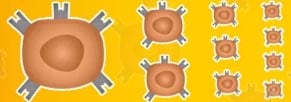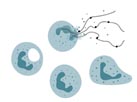
Popular topics

-
References
Delgado-Rizo V et al. (2017). Neutrophil extracellular traps and its implications in inflammation: an overview. Front Immunol., 8: 81.
Fuchs TA et al. (2007). Novel cell death program leads to neutrophil extracellular traps. J Cell Biol., 176, 231-241.
Kaplan MJ and Radic M (2012). Neutrophil extracellular traps (NETs): double-edged swords of innate immunity. J Immunol., 189, 2869-2695.
Krishnamoorthy N et al. (2018). Neutrophil cytoplasts induce TH17 differentiation and skew inflammation toward neutrophilia in severe asthma. Sci Immunol., 3, 3-16, pii: eaao4747.
Wills-Karp M (2018). Neutrophil ghosts worsen asthma. Sci Immunol., 3, 3, pii: eaau0112.
Manifestation of Ghosts Exacerbates Asthma

Asthma affects around 300 million people worldwide. Approximately 10% of asthma patients have a severe disease that doesn't improve despite taking corticosteroids regularly and correctly. Over time if poorly controlled, inflammation in the airways can lead to long-term structural changes leaving them scarred and ultimately causing more severe symptoms.
Traditionally, asthma has been associated with aberrant T helper 2 (Th2) cell immune responses leading to eosinophilic inflammation. However, around half of the patients with severe asthma have neutrophilic inflammation and it is difficult to effectively treat these patients as the pathogenesis behind the condition is poorly understood.
A new study by Krishnamoorthy et al. (2018) has identified a role for enucleated neutrophil cell bodies, known as cytoplasts or ‘ghosts’, in driving Th17 cell inflammation in severe asthma and this blog examines these new findings.
What Are Ghosts?
In response to pro-inflammatory triggers such as lipopolysaccharide (LPS), tumor necrosis factor alpha and IL-8, neutrophils can undergo a specific type of cell death called NETosis (Kaplan and Radic 2012). This process is characterized by a release of web-like chromatin fibrils and bactericidal proteins into the extracellular space. These structures, called neutrophil extracellular traps (NETs), can entrap and kill microbes, as well as initiate the inflammatory response (Fuchs et al. 2007).
Suicidal NETosis is the best described model of NETosis and here NETosis leads to the death of the cell. However, through a different mechanism called vital NETosis, neutrophils become ghosts, releasing their DNA while maintaining their nuclear and plasma membranes (Delagado-Rizo et al. 2017). This allows them to remain viable and retain some of their original cellular function. These enucleated structures, in contrast to apoptotic cells, don’t display phagocytic signals and their clearance by phagocytes is therefore prevented (Kaplan and Radic 2012). After their ‘death’, the cytoplast ghosts can carry out some functions like chemokinesis and phagocytosis, suggesting that they could have a pathological role.
Cytoplast ghosts can be identified using positive staining for markers of neutrophils: CD45+, CD11b+, Ly6G+ plus negative staining for DNA.
 Learn more about Th17 cells
Learn more about Th17 cells
Check out our T helper subsets guide, which provides an overview of the function of each subset of T helper cells.
View Guide
How Do They Make Asthma Worse?
Krishnamoorthy et al. (2018) found evidence to support a role for cytoplasts in promoting neutrophilic lung inflammation, bridging the innate and adaptive immune responses in mice by activating lung dendritic cells to differentiate naïve CD4+ T cells into Th17 effector cells. These newly generated Th17 cells release IL-17A, which increases the neutrophilic inflammatory response and further exacerbates asthma.
To study allergic lung inflammation, the authors examined bronchoalveolar lavage fluids (BALF), from mice that had been exposed to house dust mite (a common allergen) in combination with LPS (an endotoxin) for 3 days, and then challenged the mice with intranasal house dust mite. Exposure to both stimuli resulted in complex lung inflammation in these animals including: NETosis, higher numbers of neutrophils and a lower number of eosinophils compared to mice that had only been sensitized with house dust mite.
They tested the hypothesis that NETosis leads to increased numbers of neutrophils by using mice deficient in a key enzyme of NETosis (PAD4). Correspondingly these Pad4 knock-out mice had a reduction in NETosis and cytoplasts present in their BALF samples after the same house dust mite and LPS sensitization. In line with this theory, they also had a reduction of neutrophils, and reduced lung inflammation, suggesting that something about the NETosis process was causing these symptoms.
Moreover, degrading NETs using deoxyribonuclease treatment did not impact neutrophilic inflammation, indicating neutrophilia was driven by the cytoplasts formed by NETosis rather than the NETs themselves. Administering neutralizing IL-17 antibodies to the mice reduced BALF neutrophils but not lung cytoplasts, suggesting that IL-17 production didn’t affect NETosis but did have a role in increasing neutrophil numbers.
The authors therefore postulated that cytoplasts may drive CD4+ T cell differentiation to Th17 cells and indeed cytoplasts were found to be more efficient than neutrophils at promoting dendritic cell induced Th17 cell differentiation.
Therapeutic Implications
One of the barriers to effectively treat severe asthmatics is the poor understanding of the mechanism behind neutrophilic inflammation. The increased neutrophil recruitment most likely leads to tissue damage worsening symptoms. This is then further exacerbated through the traditional use of steroids to treat the condition, as steroids prolong the survival of neutrophils (Wills-Karp 2018). If these findings in mice translate to humans then it could open the door to a new way of stratifying and treating patients with severe asthma.
To determine the relevance of their findings in humans, Krishnamoorthy et al. (2018) examined BALF samples from a cohort of severe asthmatics. Similar to their findings in mice, a subset of these patients had high neutrophil counts, as well as detectable cytoplasts and NETs. These parameters may therefore be useful in identifying severe asthma patients who may benefit from a different treatment approach to conventional corticosteroid regimes.
Although questions remain about the precise signals directing NETosis, blockade of this process may provide a more tailored approach to treat neutrophilic asthma and improve outcomes for some patients with severe asthma.
Need to Identify Neutrophils?
 Neutrophils are the most abundant leukocyte found in the human blood stream and form the vanguard of the body’s cellular immune response. Bio-Rad offers a range of markers which can be used to identify neutrophils, in both mice and human samples.
Neutrophils are the most abundant leukocyte found in the human blood stream and form the vanguard of the body’s cellular immune response. Bio-Rad offers a range of markers which can be used to identify neutrophils, in both mice and human samples.
References
Delgado-Rizo V et al. (2017). Neutrophil extracellular traps and its implications in inflammation: an overview. Front Immunol., 8: 81.
Fuchs TA et al. (2007). Novel cell death program leads to neutrophil extracellular traps. J Cell Biol., 176, 231-241.
Kaplan MJ and Radic M (2012). Neutrophil extracellular traps (NETs): double-edged swords of innate immunity. J Immunol., 189, 2869-2695.
Krishnamoorthy N et al. (2018). Neutrophil cytoplasts induce TH17 differentiation and skew inflammation toward neutrophilia in severe asthma. Sci Immunol., 3, 3-16, pii: eaao4747.
Wills-Karp M (2018). Neutrophil ghosts worsen asthma. Sci Immunol., 3, 3, pii: eaau0112.
You may also be interested in...

View more Immunology or Science News blogs















